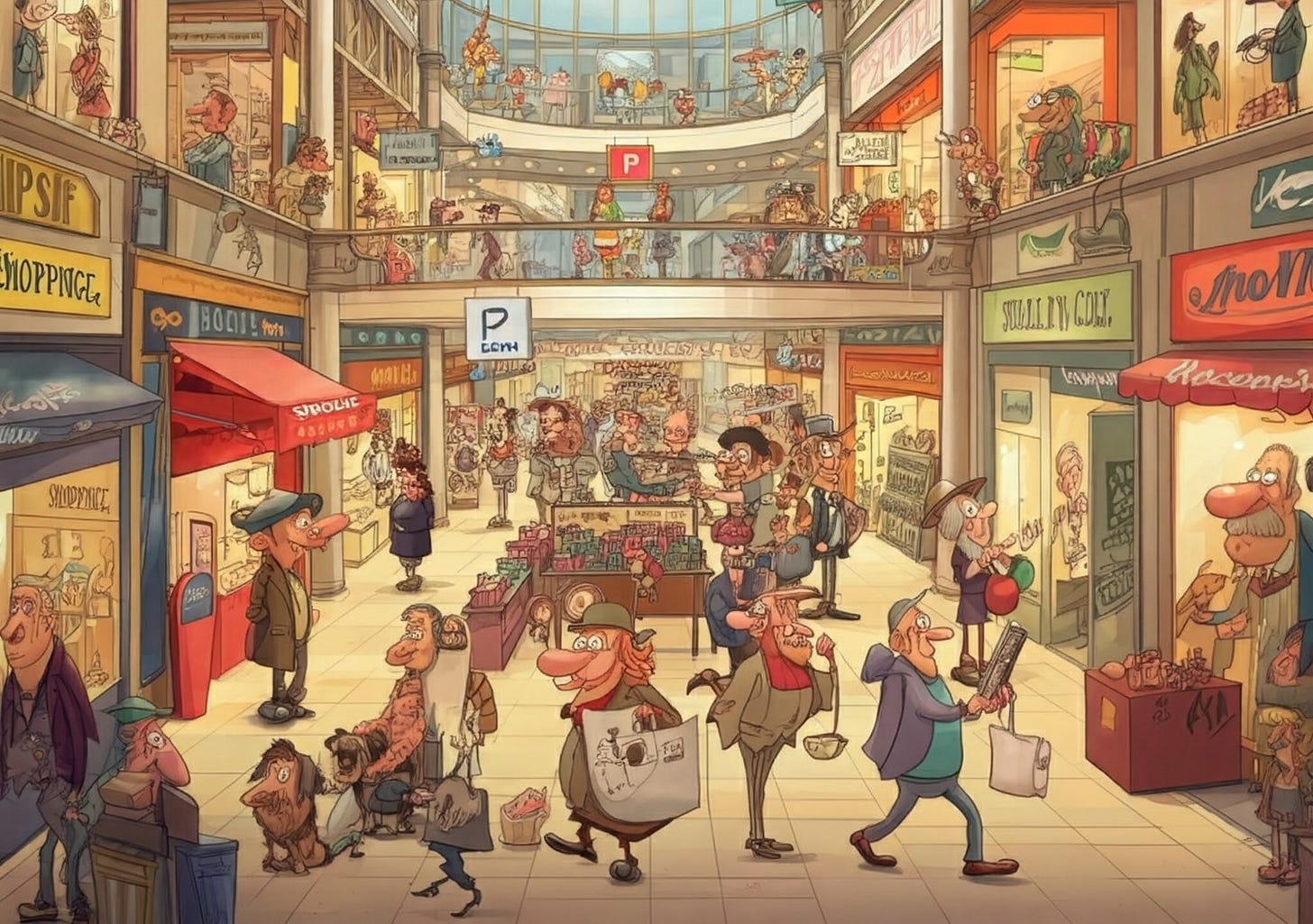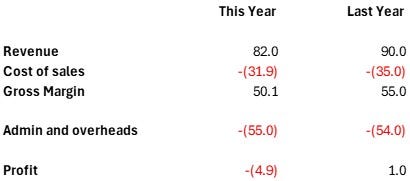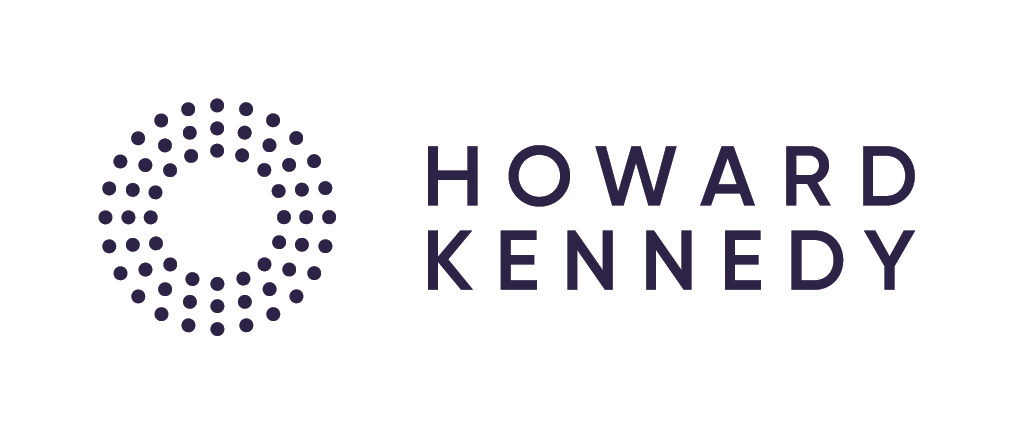Consider this comparison of how a hypothetical business has performed this year versus last:
Clearly this year is not going to be one for the memoirs, with a thumping great loss. But what has happened, exactly? This business’ Gross Margin (the excess of its revenue over the direct costs of the goods it has sold) has stayed exactly the same in percentage terms from one year to the next. Its fixed administrative costs, apart from a little bit of inflation, have also stayed the same.
What has changed, of course, is its revenue, which has dropped sharply from £90m to £82m. With a constant Gross Margin percentage that means it has generated less cash margin (sometimes called Operating Profit) and no longer generates enough to cover those fixed costs - so a small profit last year has more than disappeared this year.
Seems far fetched? Not really - with some rounding of numbers for simplicity, those are almost exactly the results reported by Quiz, the fashion retailer, a few weeks ago.
The results caught my eye because if you search for the last few years of headlines on this business you get the same dizzying mixture of “hails strong recovery” and “warns on profits” that I’ve written about on these pages before and which we see from many retail and hospitality businesses.
It is worth asking ourselves why that happens. Yes, the UK economy has hardly been a picture of stability overall either but is that enough to explain why some businesses seem to lurch from profit to loss and back again so often?
Well, yes, but only if you add in another factor. This business seems to have, for the size of its revenue line, very high central costs. Some of those will no doubt be variable costs that can flex up and down with revenue but others will be more fixed, and it is those which cause the problem.
This is the topic (which we’ve discovered before in the Moving Tribes archives) of Operational Gearing. If too much of your cost is fixed, then relatively small swings in revenue can send you straight from profit to loss. This particular business was never that profitable anyway, making it all the more vulnerable to consumer downturns or losses of market share.
And why might you have lots of fixed costs as a proportion of your sales line? Here is our topic for this week - scale.
There can be many largely fixed costs when operating a business. Store leases need to be paid whether the store trades well or not, for example. Head office and administrative functions can be hard to shrink when sales are slow. Accounts need to be done, reporting packs produced, HR processes followed. For a business which is operating as a PLC like Quiz there are lots of costs associated with the stock market listing which are hard to avoid.
Consider the very current example of Homebase, which sadly fell into administration last week. In its last published year of accounts it turned £700m of revenue into £293m of gross profit, which seems reasonable, but then had to pay out £301m of administrative costs and over £40m of distribution costs, leaving it with a huge loss at the bottom line which was obviously too much to recover. £75m of those costs, by the way, were just paying the leases on the stores.
In an environment of high fixed costs, then, a business can be very vulnerable. So what can we do to avoid that?
This is where the concept of scale comes into play. Reading the Quiz results, for example, the red light that flashed for me was realising that the business operates 68 stores. Ask any retailer and they will tell you that that is a very difficult size of business to make work. You are almost at national scale, and probably have all the administrative and logistical costs associated with being a national operator, but you have far fewer stores than larger, truly national, competitors.
If you compare a business with 68 stores with one that has 200 stores (and therefore a much stronger national footprint) then the smaller business might have half the fixed costs of the larger one, but it has way fewer than half the stores - meaning the revenue those stores have to generate just to cover the fixed costs and get into profit is a much bigger ask.
Does that mean the answer for every business is to open more and more stores? Certainly not. Firstly, not every retail model will work in every market and so you can end up opening stores that don’t even cover their own costs let alone contributing to your overheads. Secondly, the competitive environment also limits what is possible. I remember well when a whole bunch of premium burger restaurants all decided to expand from 10 sites to 100 sites at the same time - massively saturating the market and consequently all going bust.
The alternative to opening more stores might even be to have fewer. When you have only a handful of stores it is easier to keep fixed costs low. You probably run the business from the back of one of the stores and your operational processes can stay simple and cheap. A 5 to 10 store chain might well be easier to keep in profit than a 50 store one.
There is, then, a kind of ‘worst case middle ground’ where a business has expanded to the point that it needs ‘proper’ infrastructure and the associated costs, but doesn’t yet have enough revenue to properly cover those costs. If the business can’t expand further, either because it lacks the capital to do so or because the market doesn’t allow it, then it can end up in this messy space where it can make a small profit in a good year but tends to make painful losses just as often.
The lesson? If you are thinking about scaling up your own business, do so carefully and with full awareness of the increased fixed cost base you are likely to take on. And beware the middle ground!
P.S.
Moving Tribes is kept free for you to read and share thanks to generous support from partners. I’m delighted to be working with the excellent team at Howard Kennedy for this series of posts - they are a full-service legal team with a lot of experience of the kinds of issues consumer businesses often face, so do look them up if you need to.





Another great Moving Tribes update, Ian, and am important one for sure. Understanding the actual variability is key, as is modelling a number of different scenarios to help clarify and forecast when/how you could be left in the "worst case middle ground".
The other danger to consider, and playing off your hypothetical business performance, would be where the revenue line has increased a little - showing the growth that we all aspire to and lulling the organisation into a false sense of security - although all too often masking the volume/value challenge and relative inflationary effects. Without understanding what happens between the top and bottom lines, a small revenue increase which leads to a massive decline in profits can feel confusing.
Another good read Ian. Thanks. Some curiosities from someone in another retail giant here. What do you see as the cost of sales in your example? Then the summary of administrative and overhead, do you see the store costs including property costs, costs to sell, serve within this? Do you typically see the initial margin as cost of goods landed in the business units etc? And another thought on retail rents, why not buy the retail properties and appreciate the assets and benefit from owning the locations or is this just not a possibility for typical UK retail brands? Best. Gordon